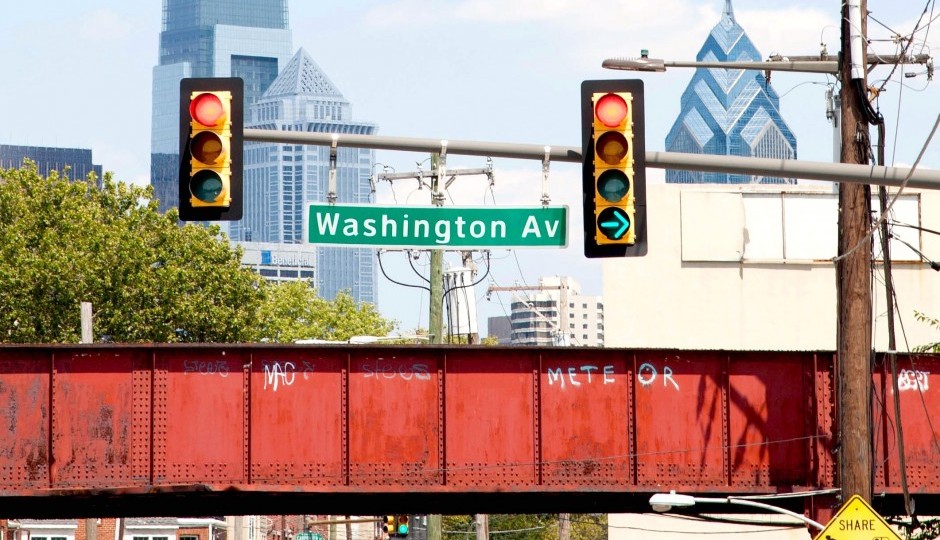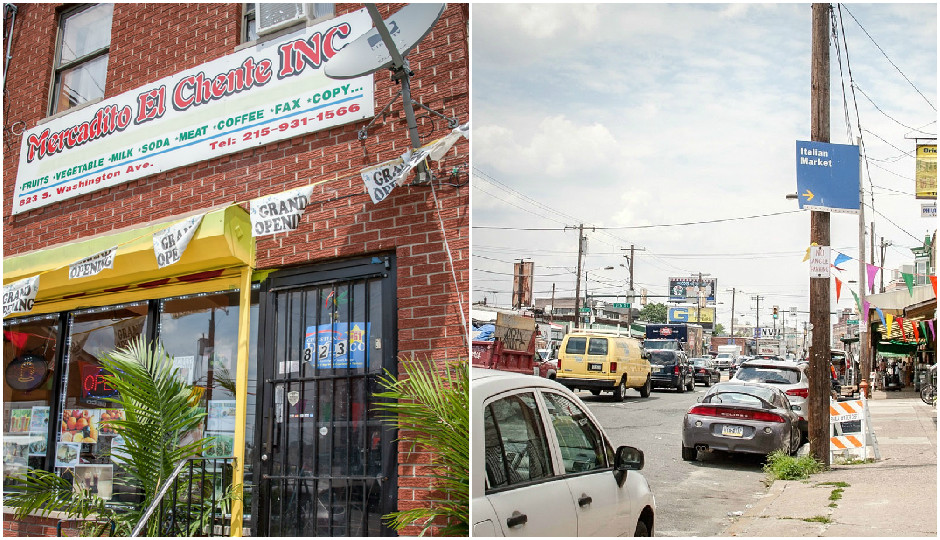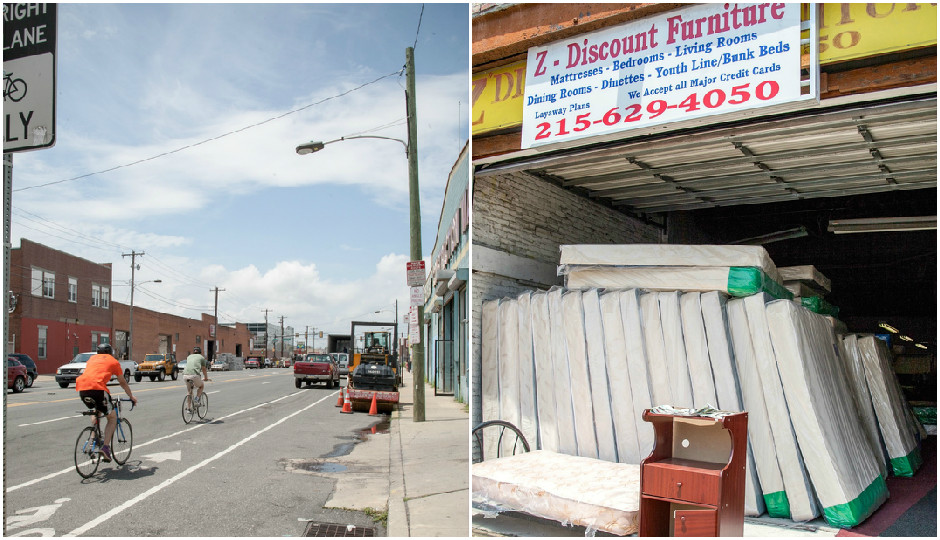The Battle for the Soul of Washington Avenue

Washington Avenue. | Photo by Stacey Emenecker.
Washington Avenue is not a Market Street or a Broad Street or even a Baltimore Avenue. The New York Times has never recommended, as it did with Passyunk Avenue, that tourists spend a sunny weekend there to check out the cafés and twee boutiques. Art lovers don’t flock there on First Fridays to sip white wine and buy clay conversation pieces, like they do on Second Street. Suburban teenagers don’t gravitate there, as they have for decades to South Street, for tattoos and piercings and pizza.
And yet, Washington Avenue is just as quintessentially Philadelphian — just as instantly recognizable — as any of those places.
Washington Avenue’s identity is iconic and jumbled, all at once. I see, on a recent visit, a co-ed team of hipsters rolling bocce balls in Jefferson Square Park at Third Street. Across the street, Mexican immigrants play soccer and African-American kids shoot baskets. Down the road, past the taco truck that smells of spit-grilled pork bathed in pineapple juice, stands the massive 1st Oriental Supermarket, which sells eels and MSG powder and endless varieties of choy, all for prices that don’t belong in this century. At Washington and 9th, the Giordanos hawk fresh fruits and vegetables, and the Anastasis dish out mussels and clams. The odor here is sometimes pretty good, often very bad and always incredibly strong.
And on the western half of Washington Ave? A jumble of warehouses and bustling industry, of abandoned buildings with bricked-in windows and vacant lots fenced off with razor wire. Up and down the thoroughfare, forklifts and 18-wheelers whiz by, offloading cinder block and sand, stacks of lumber, and refrigerators by the dozens. Pedestrians try to cross with the careful focus of a child playing Frogger.
End-to-end, Washington Avenue is chaotic. It’s ugly. It’s downright delightful.
And it’s all about to change.

Photo by Kori Livingston.
WASHINGTON AVENUE forms the spine of some of the hottest neighborhoods in Philadelphia: Point Breeze, Graduate Hospital, East Passyunk and Bella Vista. It’s also stood as the southernmost edge of greater Center City; a gritty and unforgiving moat of asphalt four lanes wide that makes it oh-so-clear you’re not in Society Hill any more.
Those facts of geography probably make Washington Avenue’s transformation inevitable. In fact, it’s already begun. Center City’s relentless growth has led legions of new Philadelphians to cross the Avenue, and they’re demanding it become, well, a more normal street. They want a Washington Avenue that is less quirky and less chaotic: fewer pastrami factories, more purveyors of artisanal charcuterie.
Developers are rushing to meet that demand. Several mega–projects are in the works on Washington Avenue, including a 32-story Bart Blatstein development at Broad Street that will feature a grocery store, shops, restaurants, 700 parking spaces and 1,600 apartments. Seeking to build on that momentum, city planners want to rezone the western half of the Avenue, much of which is now zoned for exclusively industrial uses.
When New York City rezoned industrial sections of Brooklyn a decade ago, Williamsburg and Greenpoint boomed, becoming the expensive hipster meccas they are today. Some think the effect on Washington Avenue could be similar.
“This has the chance to be more than a neighborhood commercial district. It could be a larger commercial district,” says John Grady, president of the Philadelphia Industrial Development Corporation. “It could also be a connector between the eastern and western parts of the city, which could stimulate investment. The more people are able to move around, the more attractive it is for employers to locate here.”
But in community meetings and on private Facebook groups, there is fierce debate over how — and even whether — Washington Avenue ought to change. Should it stay weird, or be gussied up? Does it really make sense to send industry packing to make room for still-more residential development? Will there still be a place for longtime residents — and low income ones — on this reinvented corridor? Can Washington Avenue evolve, and keep its soul, its inimitable character, intact?
In other words, the very same questions that Philadelphia as a whole is wrestling with. On Washington Avenue, the answers will come sooner than later.

Photos by Kori Livingston.
THE LAST TIME Washington Avenue stood on the cusp of comparably dramatic change was almost 180 years ago.
It was 1838, and the Philadelphia, Wilmington and Baltimore Railroad had just plunked down tracks on the stretch from Grays Ferry to Broad Street. Industry swarmed in. Coal yards and furniture manufacturers and steel companies set up shop. That, in turn, led to the modest rowhomes of Point Breeze: workforce housing for the new factories.
Over the next several decades, Washington Avenue helped Philadelphia get the nickname “The Workshop of the World.” Curtis Publishing Plant produced copies of the Saturday Evening Post and Ladies Home Journal. The Continental Brewery pumped out 80,000 barrels of beer a year. During the Civil War, a passenger station at Washington and Broad was used as a vital deployment point for Union soldiers traveling to battle lines. Years later, the Marine Quartermaster’s Depot at the same intersection was a critical manufacturer of uniforms for the troops during World War I and II.
Tom Donatucci, the second-generation owner of Washington Avenue’s Donatucci Kitchen, Baths & Appliances, remembers his older relatives talking about the street’s glory days in the mid-1900s. “Guys skinned sheep on Washington Avenue, and people would come down to get coal off the railroad tracks to heat their homes,” says Donatucci, whose uncle is Ron Donatucci, the city’s Register of Wills. “It was very Old World.”
By the time Madeline Shikomba started walking up and down the strip as a teenager in the ’60s, many of the coal yards were gone. But companies like Donatucci’s had opened up in their place, and Washington Avenue was still thriving. “It was a bustling avenue at the time,” says Shikomba. “There were a lot of businesses, trains going back and forth transporting materials and stuff.”
Harry Tran, a Vietnamese immigrant who now owns the bakery Ba Le at Sixth Street, remembers shopping on Washington Avenue as a boy in the 1970s. His family would travel to the Italian Market, where they could buy meats and cheeses and produce — and, in new shops opening around the corner, soy sauce. “Small Asian markets operated out of their townhouses on 8th Street,” he says. “The idea of buying soy sauce in 1977 or 1978 was a very exciting thing.”
Everything changed in the 1970s and 1980s. In Philadelphia as well as the rest of the country, the manufacturing industry cratered. On Washington Avenue, building supply stores and auto repair shops held on, but the freight rail line closed, several factories shut down, numerous properties went vacant and the street became a spooky place to many Philadelphians. Says Donatucci: “you could get whatever drug you wanted on Washington Avenue.”
Tran remembers it the same way. “Washington Avenue was not a safe place back in the day after 6 o’clock,” he says. “It was dark. It was dirty.”
But Tran and dozens of other Asian immigrants took a chance on the street anyway. Throughout the 1990s, they bought up properties along Washington Avenue, which were cheaper than those in Chinatown, and transformed them into jam-packed Asian mini-malls filled with restaurants and nail salons and the best pho in the city. Tran says the appeal was simple: “Asians from all over came here for a little taste of home, from fresh fish to sausages to dim sum.”
That investment proved critical. “The Asian markets started the revitalization of Washington Avenue that’s in effect today,” says Andy Toy, an economic development expert.
Meanwhile, the neighborhoods north of Washington Avenue were booming. In the mid-90s, the average selling price of homes in the Graduate Hospital neighborhood was about $30,000 (yes, you read that right). Today, homes in the same community regularly go for $600,000 and up.
That kind of pricing has led young, bespectacled professionals such as Jake Liefer to buy homes south of Washington Avenue, in areas such as Point Breeze. And when Liefer and other new residents head to their local commercial strip, they are disappointed. “It needs to be less of a road that you just use to exit the city, and more of one that you intentionally go to,” Liefer says.

Photos by Kori Livingston.
THE MARKET IS LISTENING.
Over the last few years, trendy eateries such as Kermit’s Bake Shoppe and Café Ynez have opened up on the west side of Washington Avenue. NextFab — “Philadelphia’s Gym for Innovators” — is now headquartered at 20th Street. CrossFit fanatics work out on 19th Street. The old Curtis Publishing Plant at 11th and Washington has been renovated and renamed the Lofts at Bella Vista. And the onetime Marine Quartermaster’s Depot is now the Marine Club Condominiums.
“Washington Avenue has always been a sleeper,” says Blatstein, the developer. “It has good bones. So now that you have the people, you have the demand for commercial businesses and the demand for housing other than townhouses.”
And everything that’s happened on Washington Ave so far is just a preview, Blatstein says. He predicts taller and taller buildings will be built on the corridor over the next 10 years. He imagines more restaurants, more cafés, more shops. Blatstein thinks the Asian strip malls will remain, but grow to be five or six stories tall, like some on the West Coast.
In fact, Blatstein believes there is the potential for $1 billion of development on Washington Avenue in just the next 10 years. That is an enormous sum. Just think: Blatstein’s entire 32-story project on Washington Avenue is projected to cost just $150 million. “A billion dollars means thousands of jobs,” he says. “It means a new population next to what’s there. It means thousands of residential units and hundreds of thousands of square feet of new commercial space.”
The combination of rising property values and larger economic forces is also putting pressure on building supply stores, auto repair shops and small-scale manufacturers — in other words, the last vestiges of Washington Avenue’s industrial past — to move off the strip.
Take, for instance, Donatucci Kitchen, Baths & Appliances. The triple-whammy of the recession, online shopping and the ever-increasing dominance of stores such as Home Depot and Lowe’s have made Donatucci feel like a relic. Back in the 1930s, his building was home to a wooden toilet seat factory. “You know what happened to wooden toilet seats, right?” says Donatucci. “So, that’s what our business is like today.”
In the coming years, many of the decent-paying industrial jobs still left on Washington Avenue are likely to be replaced with lower-paying service jobs. That doesn’t sit well with residents like Shikomba or economic development experts like Toy.
“There’s a whole slew of new industries developing, but the city has no economic plans that I know of to lure those businesses here,” says Shikomba. “We’re the poorest big city in the country, and you’re creating nothing but residential. How is that viable?” Likewise, Toy says, “I wouldn’t give up on those kinds of businesses. I don’t think an economy just of retail businesses and residential is diverse enough to be a very strong economy. I think you need all kinds of different businesses: wholesale trade, manufacturing, light manufacturing.”
The metamorphosis of Washington Avenue will be accelerated if the city’s planning commission gets its way. Right now, most of the west side of Broad Street is zoned to allow only industrial businesses such as Donatucci’s. The commission wants to rezone the area so that a mix of industrial, residential and commercial properties could be built there.
This may be the linchpin decision for western Washington Avenue. It certainly was for Williamsburg and Greenpoint in Brooklyn.
As Curbed New York’s Eli Rosenberg recently reported, “Between 2001 and 2011, the number of manufacturing jobs in the city halved. The loss was demonstrable in rezoned areas like Williamsburg. Industrial employment in the 11211 zip code dropped from around 7,500 in 2000 to 3,600 in 2009.” At the same time, though, Williamsburg became a bigger, brighter, better place in many people’s eyes. “The 2005 rezoning of almost 200 blocks of Williamsburg, and parts of neighboring Greenpoint to the north, catalyzed the transformation of the waterfront area,” wrote The New York Times.
Another looming public policy decision that could change the identity of the street — and which is proving predictably divisive — is a plan to make the street safer and more welcoming for pedestrians and bicyclists. Residents such as Liefer want Washington Avenue restriped so there is only one traffic lane in each direction, as well a center turning lane.
Liefer founded a Facebook group called “Washington Ave Advocates” to champion “a complete Washington Ave. that allows for safe pedestrian, bicycle and vehicular traffic.” Recently, a member posted an image of a mess of cars parked illegally around 22nd and Washington Avenue. “Preposterous. Outrageous. Obnoxious,” the poster wrote. “There’s barely room for my son’s stroller to go through between the cars illegally parked in a no-stopping zone and the cars illegally parked on the sidewalk.”
All of this irritates the hell out of business owners. Washington Avenue has been a center of industry for nearly 180 years. Now it’s supposed to adapt to strollers?
The Washington Avenue Property Owners Association, headed by Donatucci, opposes the plan. Tran, the owner of Ba Le, says roughly 60 Asian businesses between 5th and 8th streets do as well. “I had a delivery the other day from an 18-wheeler truck the size of a small apartment,” he says. “What’s going to happen when there’s only two lanes of traffic?”

Photos by Kori Livingston.
AS MUCH AS RESIDENTS, business owners and city planners fight over the future of Washington Avenue, there are actually a lot of places where their visions dovetail. Which is pretty amazing for a street as diverse as this one.
“We need to make Washington Avenue safer for bicyclists and pedestrians,” says City Councilman Kenyatta Johnson, who represents the west side of Washington Avenue. “Everyone agrees about that.”
Indeed, even businesspeople like Donatucci — who reject the idea of killing off vehicle lanes on the Avenue — want to upgrade the street’s bike infrastructure. He even says stuff like: “Newsweek had an article a few months ago about the most beautiful bike lanes in the world. Let’s crack that list.” City government should jump on this accord and move to make the street less treacherous ASAP.
There’s also general agreement that the city needs to rezone Washington Avenue. Eleanor Sharpe, the planning commission’s deputy executive director, says just a “few” people like Shikomba object to permitting more residential development on the strip — and my reporting confirmed that.
Part of the reason so many industrial leaders are on board with the plan is profit they could make off of it. Industrial property owners like Donatucci stand to do very well indeed if rezoning leads real estate values to jump. (Donatucci says there’s more to it than that. “We believe in a better Philadelphia,” he says, “this is our legacy.”)
So, why the holdup? Councilman Johnson, who represents the western half of the Avenue, hasn’t made a decision yet (it’s worth noting that the city’s rezoning plan was just rolled out in June). And in Philly, district council members have the final say on zoning change. But it sounds like Johnson’s instinct is to sign off — eventually. “Washington Avenue is undergoing a transformation, there is no question about it,” Johnson says. “The market is calling for large mixed-use developments with commercial or light industrial on the ground floor and residential units above.”
Those who argue the city should maintain the status quo to protect industrial jobs are failing to take broader market forces into account: the rise of Internet shopping, home supply mega-chains and increasing property values all around the corridor. Those factors make it unlikely there’s a future for 40,000-square-foot showrooms such as Donatucci’s on Washington Avenue.
Philadelphia should do all it can to preserve, and build on, what’s left of its industrial economy. But it doesn’t have to be on Washington Avenue. “A company called Fretz kitchens built a showroom at the Navy Yard,” says Grady. “There could even be some work done to create an opportunity for businesses on Washington Avenue to move together and have greater value. We could have something like the Merchandise Mart in Chicago, or like the showrooms in Old City.”
Shortly after New York City rezoned Williamsburg, Greenpoint and several other areas, it created “Industrial Business Zones,” where officials promised that industry would be safe from rezoning. The city seemed to have learned quickly that it needed to set aside a place for these companies to go after paving the way for more residential development. Philadelphia could learn from that. It could be proactive where New York City was reactive.
But there’s no stopping the change that’s coming to Washington Avenue, and it would be a mistake to try. In 10 years, the Avenue will be far safer, far denser, and far more alive, up and down its eclectic length. That’s pretty much everything you want in a city street. To get that, yes, we may have to sacrifice some of the street’s grit and so-bad-it’s-good aesthetic. But there’s a way to do this, I think, where Washington Avenue keeps its mixed-up identity, and I’ll be praying to Frank Rizzo’s mural in the Italian Market that a little bit of its signature weirdness holds on, too.